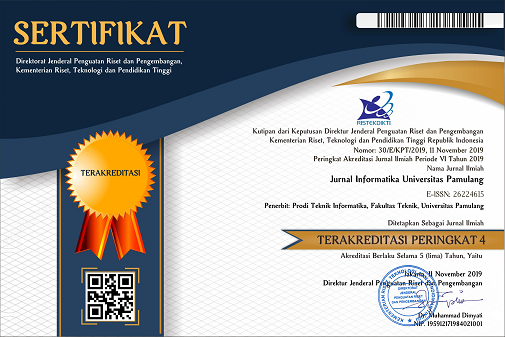Analisis Data Bank Direct Marketing dengan Perbandingan Klasifikasi Data Mining Berbasis Optimize Selection (Evolutionary)
DOI:
https://doi.org/10.32493/informatika.v6i1.9291Keywords:
Bank Direct Marketing, Data Mining, Naïve Bayes, K- Nearest Neighbor, Support Vector Machine, Optimize selection (Evolutionary).Abstract
In determining marketing strategies, the bank performs a classification from a customer database, the database will be analyzed by a decision maker and this is not easy for a decision maker, because of the complexity of the vast data and the many attributes of the data owned, so that it becomes an obstacle and obstacle. in decision making. This of course can have a negative effect on the company's business processes because there will be delays in determining marketing strategies. Data mining method is a method that can classify large data to determine the level of accuracy of a database. In overcoming these problems, it is necessary to do a database analysis to determine the accuracy level of the database classification owned by the company. For this reason, in this study a classification process will be carried out with the Bank Direct Marketing dataset taken from the UCI Machine Learning Repository web, using the Naïve Bayes algorithm, K-Nearest Neighbor, Support Vector Machine with Optimize Selection (Evolutionary) optimization, the calculation process using a data mining application. namely Rapidminer 5.3, to find the highest accuracy value from the calculation algorithm. Test method with 10-fold cross validation. In this study, the classification results with the highest level of accuracy were obtained using Optimize Selection (Evolutionary) optimization, namely the Naïve Bayes algorithm 90.18%, then K-Nearest Neighbor 86.66%, and Support Vector Machine 89.40%.
References
Ahmad Fauzi, T. (2019). Analisis Potensi Dana Retail Pada Nasabah PT. Bank Tabungan Negara (Persero).Tbk, dengan Metode Decision Tree dan Naive Bayes Berbasis Optimize Selection (Evolutionary). Jurnal Administrasi dan Manajemen Vol 9 No 1 1-7.
Amalia, H. (2016). Komparasi Metode Data Mining Untuk Prediksi Pemasaran Bank Secara Langsung. SNIPTEK2016, 1-6.
Arisawati, E. (2017). Penerapan K-Nearest NeighBor Berbasis Genetic Algorithm Untuk Penentuan Pemberian Kredit. Jurnal Sains Komputer & Informatika (J-Sakti), 1-11.
Irvi Oktanisa, A. A. (2018). Perbandingan Teknik Klasifikasi Dalam Data Mining Untuk Bank Direct Marketing. Jurnal Teknologi Informasi Dan Ilmu Komputer (JTIIK), 567-576.
Sulaehani, R. (2016). Prediksi Keputusan Klien Telemarketing Untuk Deposito Pada Bank Menggunakan Algoritma Naive Bayes Berbasis Backward Elimination. Jurnal Ilmiah ILKOM, 1-8.
Yunial, A. H. (2020). Analisis Optimasi Algoritma Klasifikasi Support Vector Machine, Decision Tree, dan Neural Network Menggunakan Adaboost dan Bagging. Jurnal Informatika Universitas Pamulang, 247-260.
A.Elsalamony, H. (2014). Bank Direct Marketing Analysis of Data Mining Techniques . International Jurnal of Computer Applications, 12-22.
Akhmad, E. P. (2019). Evaluasi Telemarketing Kartu Kredit Bank Menggunakan algoritma Genetika untuk Seleksi Fitur dan Naive Bayes. Jurnal Aplikasi Palayaran dan Kepelabuhan, 12-22.
Bonggo Bawono, R. W. (2019). Perbandingan Metode random Forest dan Naive Bayes Untuk Klasifikasi Debitur Berdasarkan Kualitas Kredit. Seminar Nasional Edusaintek FMIPA UNIMUS, 343-348.
Ispandi. (2015). Penerapan Algoritma Genetika untuk Optimasi Parameter pada Support Vector Machine untuk Meningkat Prediksi Pemasaran Langsung. Jurnal Of Intelligent Systems, 115-119.
Pungkas Subarkah, E. P. (2020). Perbandingan Metode Klasifikasi Data Mining untuk Nasabah Bank Telemarketing. Jurnal Manajemen, Teknik Informatika dan Rekayasa Komputer, 139-148.
Rousyati, a. N. (2021). Komparasi Adaboost dan Bagging dengan Naive Bayes pada DataSet Bank Direct Marketing . Bianglala Informatika, 12-16.
Downloads
Published
Issue
Section
License
Authors who publish with this journal agree to the following terms:
- Authors retain copyright and grant the journal right of first publication with the work simultaneously licensed under a Creative Commons Attribution-NonCommercial 4.0 International (CC BY-NC 4.0) that allows others to share the work with an acknowledgement of the work's authorship and initial publication in this journal.
- Authors are able to enter into separate, additional contractual arrangements for the non-exclusive distribution of the journal's published version of the work (e.g., post it to an institutional repository or publish it in a book), with an acknowledgement of its initial publication in this journal.
- Authors are permitted and encouraged to post their work online (e.g., in institutional repositories or on their website) prior to and during the submission process, as it can lead to productive exchanges, as well as earlier and greater citation of published work (See The Effect of Open Access).
Jurnal Informatika Universitas Pamulang have CC-BY-NC or an equivalent license as the optimal license for the publication, distribution, use, and reuse of scholarly work.
In developing strategy and setting priorities, Jurnal Informatika Universitas Pamulang recognize that free access is better than priced access, libre access is better than free access, and libre under CC-BY-NC or the equivalent is better than libre under more restrictive open licenses. We should achieve what we can when we can. We should not delay achieving free in order to achieve libre, and we should not stop with free when we can achieve libre.
Jurnal Informatika Universitas Pamulang is licensed under a Creative Commons Attribution-NonCommercial 4.0 International (CC BY-NC 4.0)
YOU ARE FREE TO:
- Share : copy and redistribute the material in any medium or format
- Adapt : remix, transform, and build upon the material for any purpose, even commercially.
- The licensor cannot revoke these freedoms as long as you follow the license terms





